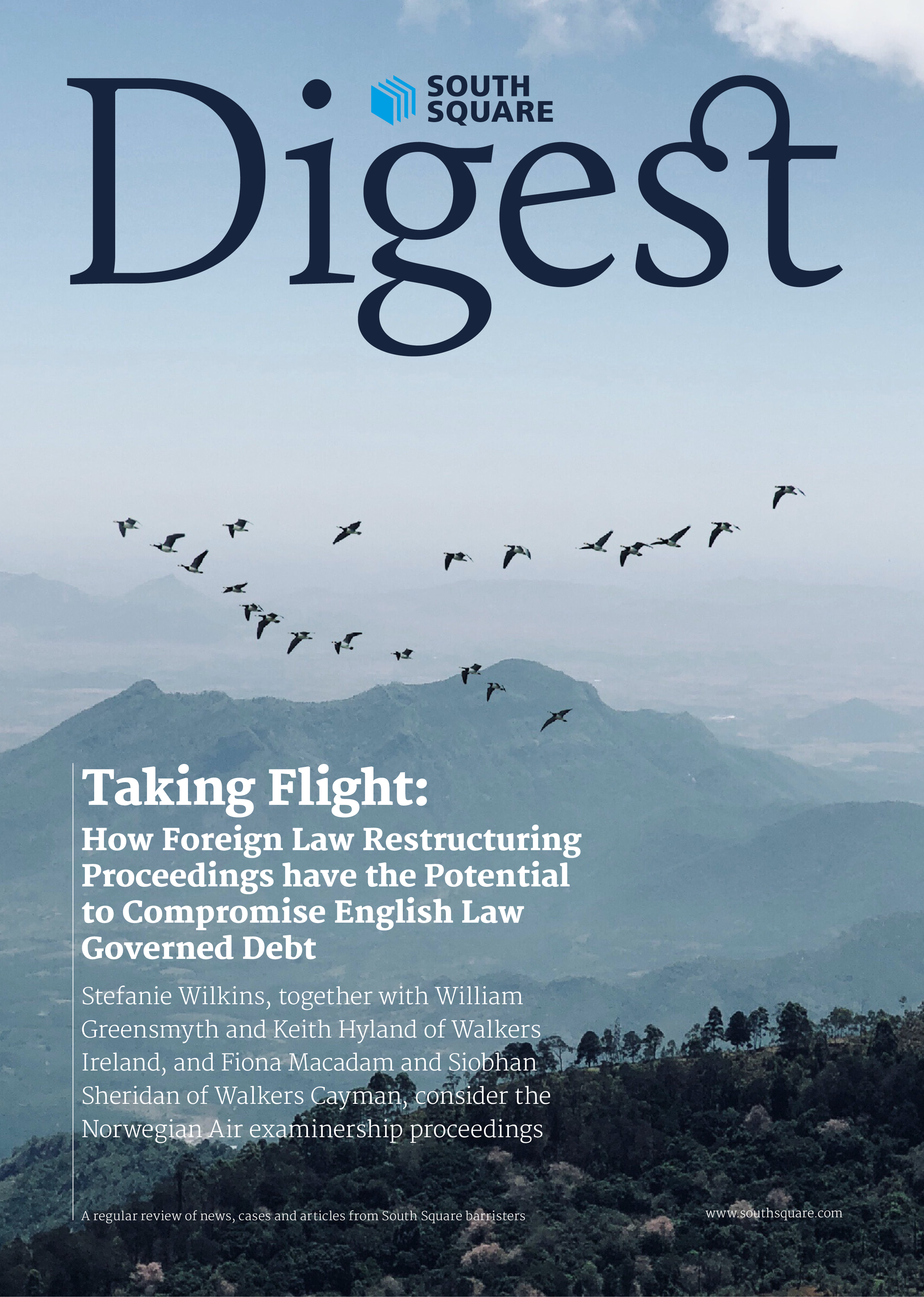
Key Points:
- Widely-used cryptocurrencies such as Bitcoin and ETH may qualify as ‘money’ and be recoverable as debt if the English court adopts the FMLC’s definition of ‘money’, or something similar.
- A purposive construction of Insolvency (England and Wales) Rules 2016 r.14.21 arguably requires that it apply to proofs of debt based on payments in cryptocurrency – which benefits a crypto-creditor if the crypto-asset
falls in value after the date of commencement of insolvency and there is sufficient value in the estate.
Abstract:
This article considers, briefly, whether a claim for payment in cryptocurrency can (arguably) be brought as a claim in debt.
It also considers the implications of such a characterisation in two specific areas of insolvency law – petitions for bankruptcy, and whether a proof of debt based on a cryptocurrency payment obligation can benefit from the Insolvency (England and Wales) Rules 2016 (“IR 2016”) r.14.21, which values the claim in sterling by reference to the exchange rate at the commencement of insolvency.
These issues are likely to interest lenders under crypto-loans(which we shall call ‘crypto-lenders’), insolvency practitioners, and others in the crypto space.
A. The claim in debt and the cryptosphere
Lawyers, bankers and insolvency practitioners will be familiar with the ‘claim in debt’. Simply speaking, this is a claim for a sum owed under a contract, or other obligation. It differs from a claim in damages, which is a claim for loss measured in monetary terms. In legal terms, a claim in debt enforces a primary, not a secondary, obligation.
Common examples of claims in debt are a customer’s claim against their bank, or a bank’s claim for payment due under a loan.
Among other advantages:
- A claimant in debt need not prove loss, and has no duty to mitigate;
- Claims in debt are freely assignable, and can therefore be factored easily, but claims for damages can often only be assigned subject to onerous restrictions;
- A debt claimant will usually be granted summary judgment;
- A separate claim in damages representing the devaluation of an unpaid, or delayed, debt can be brought if the creditor can show that they would quickly have converted the payment currency into another currency.1 The creditor can also claim for loss resulting from being kept out of their money;2 and
- Finally, the court can order a debt owed by A to B, to be paid to C, using a third-party debt order under CPR 72.2. A is usually a financial institution, B a judgment debtor, and C a judgment creditor. The third-party debt order is the functional equivalent of the garnishee order still in use in various offshore and Commonwealth jurisdictions.
Cryptocurrency often serves as the economic equivalent of money in the US$1tn digital asset market.3 Countless crypto-loans are now denominated in Bitcoin or Ethereum. Contracts for the sale of cryptoassets such as NFTs, as well as physical assets and services, are also denominated in cryptocurrency.
Naturally, market participants may wonder if a claim for repayment of a loan denominated in cryptocurrency, can be cast as claim in debt. A crypto-creditor may wish to petition for bankruptcy based on a crypto-loan or crypto-guarantee.
Civil fraud practitioners may wish to attach crypto-debts owed to fraudsters. And one may wish to use the IR 2016, 14.21 to preserve the value of one’s crypto-debt in a falling market, assuming there is value in the estate. Is any of this possible?
It is now fairly widely accepted that cryptocurrencies are property in the eyes of the common law, although the reasons remain uncertain.4 We will not dwell on these issues. The nature of a claim for payment in cryptocurrency, and whether it is ‘in debt’, has received less attention.5 In Ion Science v Persons Unknown (Unreported, 28 January 2022), the English High Court made a third-party debt order over an account in a crypto-exchange containing both cash and cryptocurrency, but it is unclear if the order was to pay the judgment creditor the cash alone, or the cash and the crypto.
We, therefore, briefly consider whether the English courts or other common law courts might allow a claim for payment in cryptocurrency to be brought as a claim in debt.
B. Are cryptocurrencies ‘money’ which can be claimed in debt at common law?
The action in debt has ancient roots. It is available when money is due pursuant to an obligation, however arising, to pay or repay the money.6 The obligation may be one to pay money under a loan or contract for sale, or other obligation. However, neither a claim to pay damages, nor even one for liquidated damages, can be brought in ‘debt’.7
The right to sue for the debt, without further notice, generally arises once the obligation to pay is enlivened under the contract, or other obligation.8 In the case of a loan or sum payable on demand, the right to sue arises once the defendant has had a reasonable chance to make payment arrangements.9
Most importantly, a claim in debt must be for a definite sum of money.10 It is this that poses the greatest challenge to crypto-creditors. If cryptocurrency is not money, but a commodity, a claim for ‘payment’ is simply a form of claim for non-delivery that can only sound in damages.
An obligation to pay in a foreign currency can be enforced by a claim in debt, and the debtor will have to pay the debt in that currency regardless of any exchange rate fluctuations.11 However, this principle is drawn from a line of cases involving fiat currencies issued by states.12 Bitcoin, ETH, Tether, Solana and other cryptocurrencies are not state-issued fiat. The question of whether cryptocurrency is ‘money’ for these purposes is a novel question which the courts have not yet answered.
This issue must, therefore, be considered from first principles.
Neither English law nor (it seems) the common law as it applies in other Commonwealth states has a single, unifying theory of what ‘money’ is.13 Most legal systems have, historically, assumed that currency is ‘money if issued and backed by a state (the ‘state theory’). A different way of formulating this theory is that ‘money’ must be backed by some country.
For example, under English law, the law of the country in whose currency a contractual debt is expressed will determine what legal tender can be used to discharge it, regardless of the governing law of the debt itself.14 That seems to assume that the currency is issued by a country.
There is good reason to believe that English law is not so limited. The ‘state theory’ does not fit easily with the fact that credits in bank accounts – which are a claim against a private entity and not themselves issued by a country – are ‘money’ under English law. It would be absurd to argue otherwise.
An alternative theory of ‘money’ is that money is to be treated by the law as such if it is widely accepted as a means of exchange (for goods and services) and a store of value, whether or not it is also a unit of sovereign currency.15
Building on this view, the UK’s Financial Markets Law Committee (FMLC) has since concluded, after exhaustively considering both sociological and economic theories of money, that “virtual currencies which have achieved status as a medium of exchange within a significant user committee have a good claim to be regarded as money.”16
That conclusion, however, did not put these questions to rest. The UK Cryptoassets Taskforce concluded, in 2018, that cryptocurrency should not be considered ‘money’ because they are too volatile to be a good store of value, are not widely-accepted as means of exchange, and not used as units of account (that can be used to value goods and services, record debts and make calculations).17
There are good reasons to prefer the FMLC’s conclusion, at least in this context. First, at least some cryptocurrencies are widely used as units of account. They may not be universally accepted – but no foreign currency is. All foreign currencies are accepted as means of exchange within significant user communities, which community may span one or several countries. Second, volatility cannot be a ground to exclude something from the definition of money. If it was, the Italian lire (in the past) and the Turkish lira (today) would not be ‘money’. That would be absurd. Finally, and fundamentally, the genius of the common law is its ability to adapt and responds to society’s needs and how society uses technology. It can – up to a point – do the same for crypto.18
Thus, cryptocurrencies, in principle, may well be ‘money’, at least for the purposes of a claim in debt at common law.
Not all cryptocurrencies will be able to claim that title.
Widely-used cryptocurrencies such as Bitcoin and ETH will almost certainly qualify as money if the English court adopts the FMLC’s definition of ‘money’, or something similar. A claim for payment in the most prolific cryptocurrencies could, therefore, be enforced by an action in debt.
It is less certain if more exotic coins (say, Axie Infinity), or coins issued by particular exchanges (think Binance USD, or FTX Token) or ‘memecoins’ (think Shiba Inu), will be ‘money’. Many of these are in practice traded as commodities and not widely used as a medium of exchange or store of value. That is not to say that only Bitcoin and Ethereum will ever qualify as ‘money’ under this definition. Some lesser-known but widely used coins (such as Solana) may arguably have a claim to being ‘money’ for these purposes.
The upshot is that, assuming cryptocurrency is ‘money’ in the first place, a claimant seeking to recover all but the most widespread cryptocurrencies will probably have to establish that that particular cryptocurrency is ‘money’ in the law’s eyes. That might require expert evidence of some kind. In practice there is thus likely to be some uncertainty for those seeking to bring debt actions to enforce payment in all but the most widely-used tokens.
C. Insolvency
The nature of a claim in cryptocurrency also has implications in insolvency. We examine two areas of interest below.
Bankruptcy
Under the Insolvency Act 1986, s.267(2)(b), a creditors’ bankruptcy petition must be based on a debt for a liquidated sum. So must the statutory demand that typically precedes the petition.19 A petition debt need not be a specific sum of money per se, but can be a “pre-ascertained liability” under an agreement, including a “contractual liability where the amount due is to be ascertained in accordance with a contractual formula or contractual machinery to produce a figure.” 20 So, a statutory provision allowing the Law Society to recover any costs incurred by the Society created a pre-ascertained liability, though the paying solicitor had a statutory right to an assessment.21
This seems to create wiggle room for an interesting argument. A petitioning crypto-creditor may wish to avoid the uncertainty of arguing that his claim to payment in crypto-currency is a claim to payment in money. That creditor may instead say that a liability to pay cryptocurrency is a debt for a liquidated sum because it can be easily ascertained by reference to the prevailing exchange rate.
This argument is, in our view, unlikely to succeed. In McGuinness and Blavo the relevant contract and statute each gave the petitioning creditor a right to a specific sum of money.
On the other hand, the holder of cryptocurrency simply has a power to exchange their crypto for fiat.22
Therefore, assuming that cryptocurrency is not characterised as ‘money’ in the first place – though we have argued that the most widely used forms of crypto should be – it is unlikely that an obligation to pay in cryptocurrency alone can be a petition debt. Indeed, were the position otherwise, anyone owed delivery of any widely-traded commodity would, in principle, be able to bankrupt the other party simply for failure to deliver.
Of course, the position may be different if the crypto-loan, or perhaps its master agreement or other agreement incorporated by reference,23 contains some contractual mechanism for converting the cryptocurrency owed to a fiat currency sum payable to the petitioner.
Proving a crypto-debt
A wide range of claims are provable in a liquidation, administration or bankruptcy, including debt claims, certain or contingent claims, or claims sounding in damages alone.24 Therefore, a crypto-creditor is unlikely to face any issue with proving in insolvency – whether their claim for non-payment is characterised as one for debt or damages.
A more interesting question is whether a crypto-creditor can benefit from IR 2016, r.14.21. Under this rule, a proof of debt in “foreign currency” is converted to sterling by reference to the exchange rate at the date of commencement of a liquidation or administration.25 This benefits the proving creditor if that currency later depreciates against sterling.
On the face of it, cryptocurrency is not “foreign” currency. R.14.21 was introduced in the Insolvency Rules 1986 alongside the 1986 Act. Cryptocurrency did not exist then.
However, the principle underpinning r.14.21 is that the company’s liabilities should be distributed to creditors as if the distribution occurred at the commencement of the insolvency. This is done to reduce arbitrariness and ensure equality among creditors.26 This also appears to be part of the reason why, if the foreign currency strengthens, the proving creditor’s loss cannot be claimed as a non-provable debt.27
It is, therefore, at least arguable that a purposive construction of r.14.21 requires that it apply to proofs of debt based on payments in cryptocurrency – perhaps even if cryptocurrency is not ‘money’ for other purposes.28 Like foreign currency debts, converting proofs based on non-payment of cryptocurrency to sterling at the date of proof or at some other date would inflate or deflate those claims arbitrarily. This would run counter to the need to treat creditors equally, and the pari passu distribution scheme.
Thus, these claims should fall within r.14.21 and be converted at the date of commencement of a liquidation or administration.
This conclusion is practically important. A series of liquidity crunches, insolvencies, hacks and regulatory moves have recently caused the prices of most crypto-assets to fall sharply. Bitcoin is a case in point. The value of 1 BTC has declined from over £45,000 in November 2021, to under £15,000 at the date of writing. Therefore, a crypto-creditor whose debtor went insolvent some time ago may gain, rather than lose, from these market fluctuations – if that creditor relies on r.14.21.
D. Conclusion
The ‘crypto winter’ shows no sign of thaw. However, cryptocurrencies are likely to remain a permanent feature of our lives for years to come. While many cryptocurrencies will continue to be traded mainly as commodities, the most popular – such as BTC and ETH – may well be increasingly used as money. The common law, and the creative practitioner, will respond accordingly.
This article first appeared in the January 2023 edition of Butterworths Journal of International Banking and Financial Law.
1International Minerals and Chemical Corp v Karl O Helm AG [1986] 1 Lloyd’s Rep 81, 101 (Hobhouse J).
2Sempra Metals v IRC [2008] 1 AC 561.v
3See, e.g. https://www.ft.com/content/dcea81b9-70c3-486d-9622-b9cdd84da3fc> (accessed 9 November 2022).
4See the UKJT’s Legal Statement on Cryptoassets and Smart Contracts (November 2019); AA v Persons Unknown [2020] 4 WLR 35; Kardachi v Torque Group Holdings Ltd (BVIHC(COM) 31 of 2021); CLM v CLN [2022] SGHC 46.
5See, however, Mr Justice Zacaroli’s speech to the Insolvency Lawyers’ Association (17 October 2019), and Riddiford, “Cryptoassets, Cryptoliabilities” (South Square Digest, Nov 2019), which touch on the issue.
6R (Kemp) v Denbighshire Local Health Board [2007] 1 WLR 639 at [86].
7President of India v Lips Maritime Corp [1988] AC 395.
8Bradford Old Bank Ltd v Sutcliffe [1918] 2 KB 833, 848.
9Bank of Baroda v Panessar [1987] Ch 335.
10International Minerals and Chemical Corp v Karl O Helm AG [1986] 1 Lloyd’s Rep 81, 101 (Hobhouse J).
11Sempra Metals v IRC [2008] 1 AC 561.
12See, e.g. https://www.ft.com/content/dcea81b9-70c3-486d-9622-b9cdd84da3fc> (accessed 9 November 2022).
13See the UKJT’s Legal Statement on Cryptoassets and Smart Contracts (November 2019); AA v Persons Unknown [2020] 4 WLR 35; Kardachi v Torque Group Holdings Ltd (BVIHC(COM) 31 of 2021); CLM v CLN [2022] SGHC 46.
14See, however, Mr Justice Zacaroli’s speech to the Insolvency Lawyers’ Association (17 October 2019), and Riddiford, “Cryptoassets, Cryptoliabilities” (South Square Digest, Nov 2019), which touch on the issue.
15R (Kemp) v Denbighshire Local Health Board [2007] 1 WLR 639 at [86].
16President of India v Lips Maritime Corp [1988] AC 395.
17Bradford Old Bank Ltd v Sutcliffe [1918] 2 KB 833, 848.
18Bank of Baroda v Panessar [1987] Ch 335.
19Jervis v Harris [1996] Ch 195, 202; Standard Chartered Bank v Dorchester LNG [2016] QB 1 at [38].
20Camdex International Ltd v Bank of Zambia [1997] CLC 714, 733.
21See Chitty on Contracts (34th 2021) at 33-302.
22Financial Markets Law Committee, Issues of Legal Uncertainty Arising in the Context of Virtual Currencies (July 2016).
23See e.g. Re Chesterman’s Trusts [1923] 2 Ch 466, 483.
24Proctor, Mann on the Legal Aspect of Money (7th Ed 2012) at 1.29.
25Financial Markets Law Committee, Issues of Legal Uncertainty Arising in the Context of Virtual Currencies (July 2016), p.23.
26Cryptoassets Taskforce – Final Report (October 2018) at 2.13.
27See Justice Phillip Jeyaretnam’s Keynote Address at the Singapore Trustees’ Association Conference 2022 (7 November 2022).
28Orrick, Herrington & Sutcliffe (Europe) LLP v Frohlich [2012] BPIR 169 at [23].
29McGuinness v Norwich and Peterborough Building Society [2012] 2 All ER (Comm) 265 at [36].
30Blavo v Law Society [2019] 1 WLR 1977 at [195]-[196].
31Fox and Green, Cryptocurrencies in Public and Private Law (2019), 2.31-2.33.
32See Ex parte Ward (1882) 22 Ch D 132.
33IR 2016, r.14.2(1).
34IR 2016, r.14.21.
35Report of the Cork Committee (1982 Cmnd 8558), para 1308-1309; see also Re Dynamics Corporation of America [1976] 1 WLR 757 at 763-765.
36Re Lehman Brothers International [2018] AC 465, especially [91].
37See Mr Justice Zacaroli’s brief comments in his speech to the Insolvency Lawyers’ Association (17 October 2019).








![Brake & Anor v The Chedington Court Estate Ltd [2023] UKSC 29](https://southsquare.com/wp-content/uploads/2024/02/Brake-Anor-1-scaled.jpeg)






